Comprehensive Financial Analysis of JPMorgan Chase & Co. Report
VerifiedAdded on 2019/09/19
|10
|2374
|356
Report
AI Summary
This report presents a financial analysis of JPMorgan Chase & Co., examining its performance through various financial ratios including profitability, liquidity, efficiency, and investment ratios. The analysis delves into the company's financial standing, highlighting key metrics such as return on equity, debt-equity ratio, assets turnover ratio, and price-earnings ratio. Furthermore, the report provides an overview of the global economic and sector outlook, specifically focusing on the banking industry. The analysis includes an introduction to JPMorgan Chase & Co., its services, and market position, followed by an assessment of the company's financial health based on the aforementioned ratios. The conclusion summarizes the key findings, emphasizing the company's strong performance and providing insights into its future prospects within the financial sector. The report uses data from 2014, 2015 and 2016 to assess the company's performance and includes references from various sources.
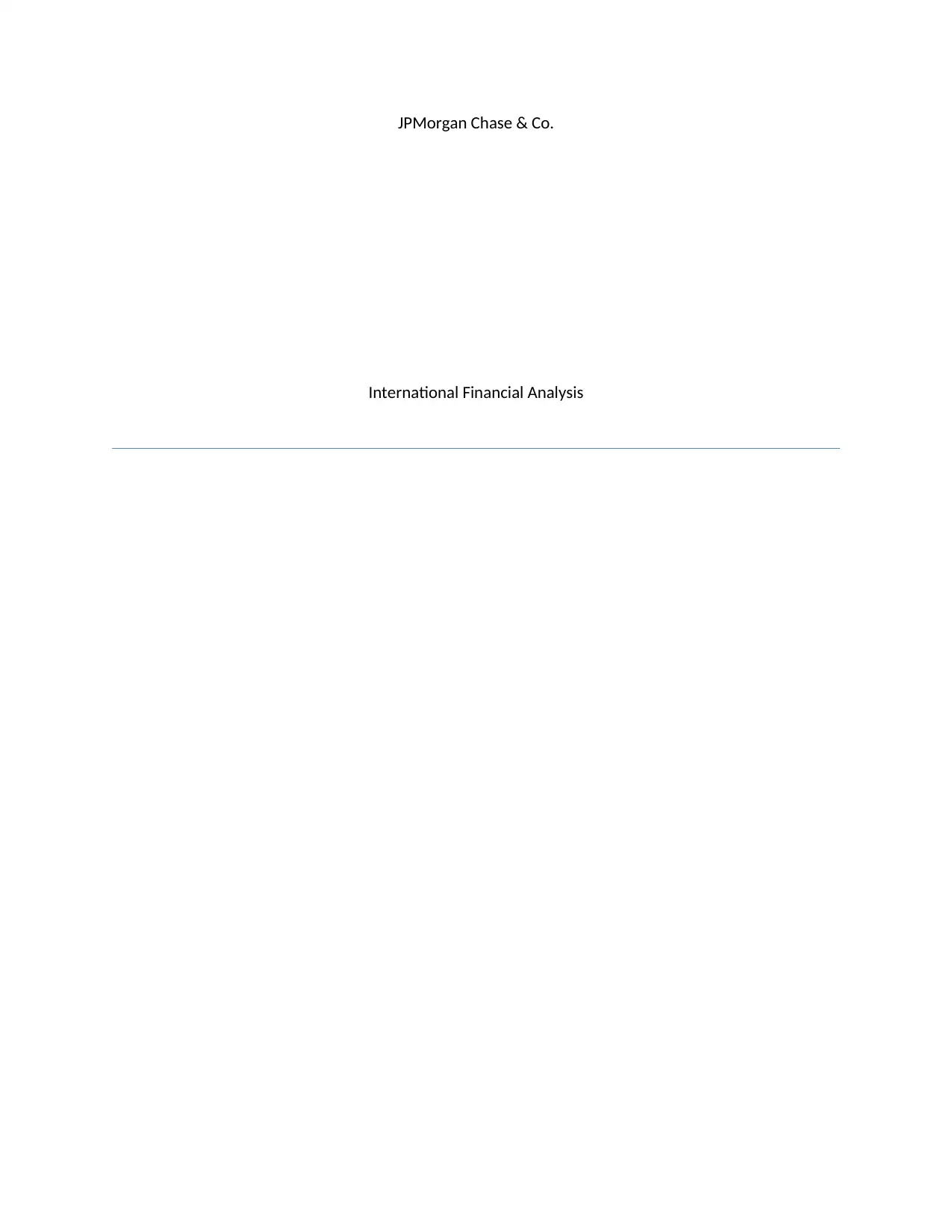
JPMorgan Chase & Co.
International Financial Analysis
International Financial Analysis
Paraphrase This Document
Need a fresh take? Get an instant paraphrase of this document with our AI Paraphraser
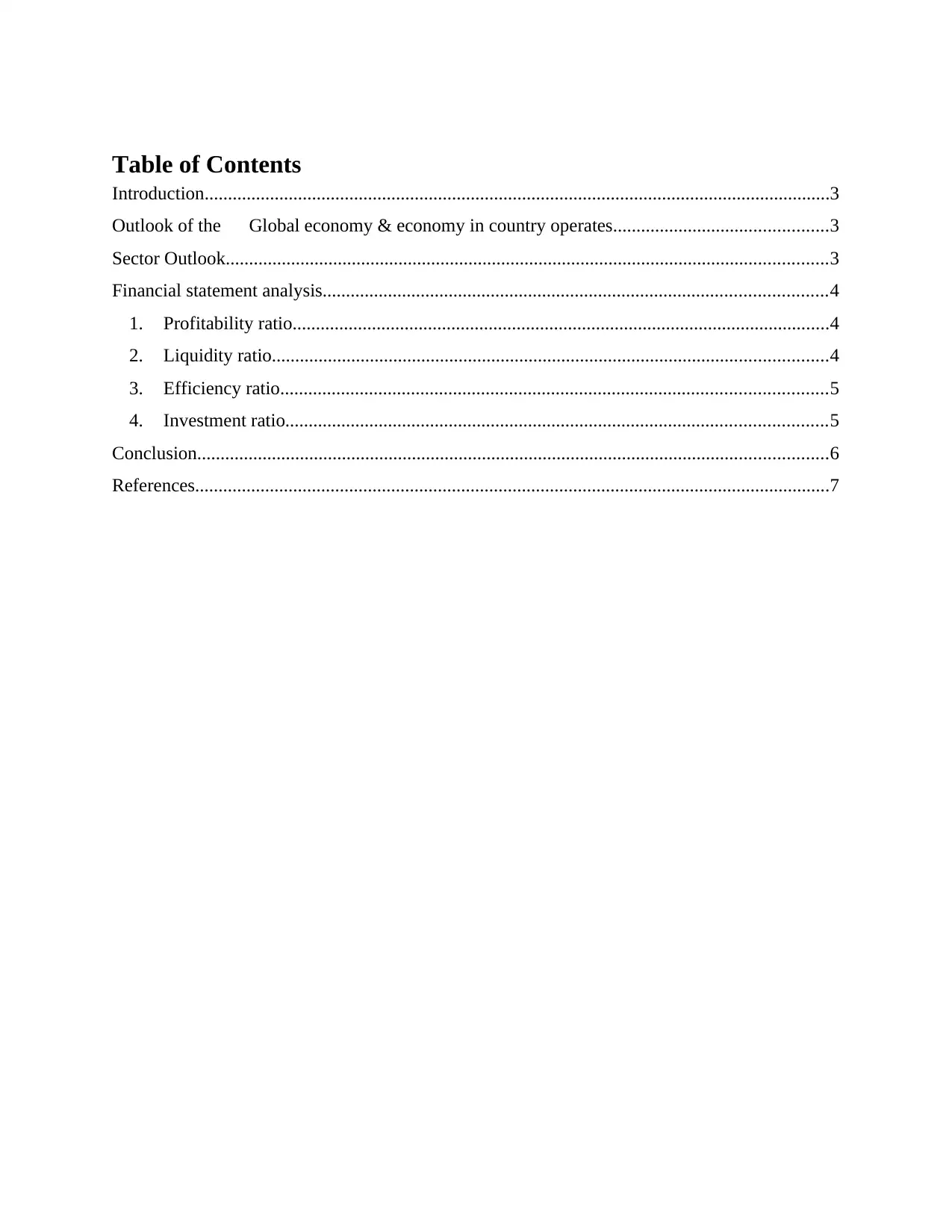
Table of Contents
Introduction......................................................................................................................................3
Outlook of the Global economy & economy in country operates..............................................3
Sector Outlook.................................................................................................................................3
Financial statement analysis............................................................................................................4
1. Profitability ratio...................................................................................................................4
2. Liquidity ratio.......................................................................................................................4
3. Efficiency ratio.....................................................................................................................5
4. Investment ratio....................................................................................................................5
Conclusion.......................................................................................................................................6
References........................................................................................................................................7
Introduction......................................................................................................................................3
Outlook of the Global economy & economy in country operates..............................................3
Sector Outlook.................................................................................................................................3
Financial statement analysis............................................................................................................4
1. Profitability ratio...................................................................................................................4
2. Liquidity ratio.......................................................................................................................4
3. Efficiency ratio.....................................................................................................................5
4. Investment ratio....................................................................................................................5
Conclusion.......................................................................................................................................6
References........................................................................................................................................7
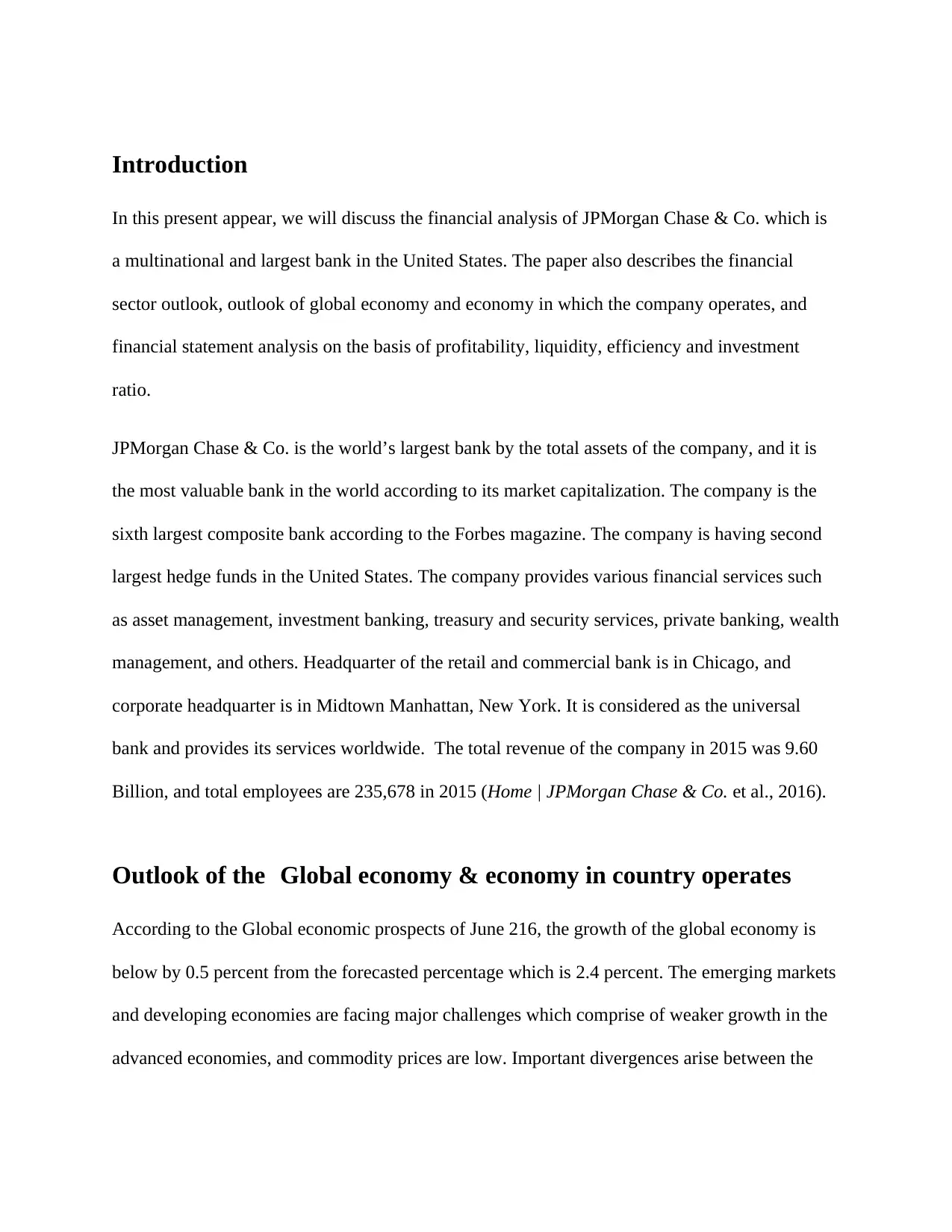
Introduction
In this present appear, we will discuss the financial analysis of JPMorgan Chase & Co. which is
a multinational and largest bank in the United States. The paper also describes the financial
sector outlook, outlook of global economy and economy in which the company operates, and
financial statement analysis on the basis of profitability, liquidity, efficiency and investment
ratio.
JPMorgan Chase & Co. is the world’s largest bank by the total assets of the company, and it is
the most valuable bank in the world according to its market capitalization. The company is the
sixth largest composite bank according to the Forbes magazine. The company is having second
largest hedge funds in the United States. The company provides various financial services such
as asset management, investment banking, treasury and security services, private banking, wealth
management, and others. Headquarter of the retail and commercial bank is in Chicago, and
corporate headquarter is in Midtown Manhattan, New York. It is considered as the universal
bank and provides its services worldwide. The total revenue of the company in 2015 was 9.60
Billion, and total employees are 235,678 in 2015 (Home | JPMorgan Chase & Co. et al., 2016).
Outlook of the Global economy & economy in country operates
According to the Global economic prospects of June 216, the growth of the global economy is
below by 0.5 percent from the forecasted percentage which is 2.4 percent. The emerging markets
and developing economies are facing major challenges which comprise of weaker growth in the
advanced economies, and commodity prices are low. Important divergences arise between the
In this present appear, we will discuss the financial analysis of JPMorgan Chase & Co. which is
a multinational and largest bank in the United States. The paper also describes the financial
sector outlook, outlook of global economy and economy in which the company operates, and
financial statement analysis on the basis of profitability, liquidity, efficiency and investment
ratio.
JPMorgan Chase & Co. is the world’s largest bank by the total assets of the company, and it is
the most valuable bank in the world according to its market capitalization. The company is the
sixth largest composite bank according to the Forbes magazine. The company is having second
largest hedge funds in the United States. The company provides various financial services such
as asset management, investment banking, treasury and security services, private banking, wealth
management, and others. Headquarter of the retail and commercial bank is in Chicago, and
corporate headquarter is in Midtown Manhattan, New York. It is considered as the universal
bank and provides its services worldwide. The total revenue of the company in 2015 was 9.60
Billion, and total employees are 235,678 in 2015 (Home | JPMorgan Chase & Co. et al., 2016).
Outlook of the Global economy & economy in country operates
According to the Global economic prospects of June 216, the growth of the global economy is
below by 0.5 percent from the forecasted percentage which is 2.4 percent. The emerging markets
and developing economies are facing major challenges which comprise of weaker growth in the
advanced economies, and commodity prices are low. Important divergences arise between the
⊘ This is a preview!⊘
Do you want full access?
Subscribe today to unlock all pages.

Trusted by 1+ million students worldwide
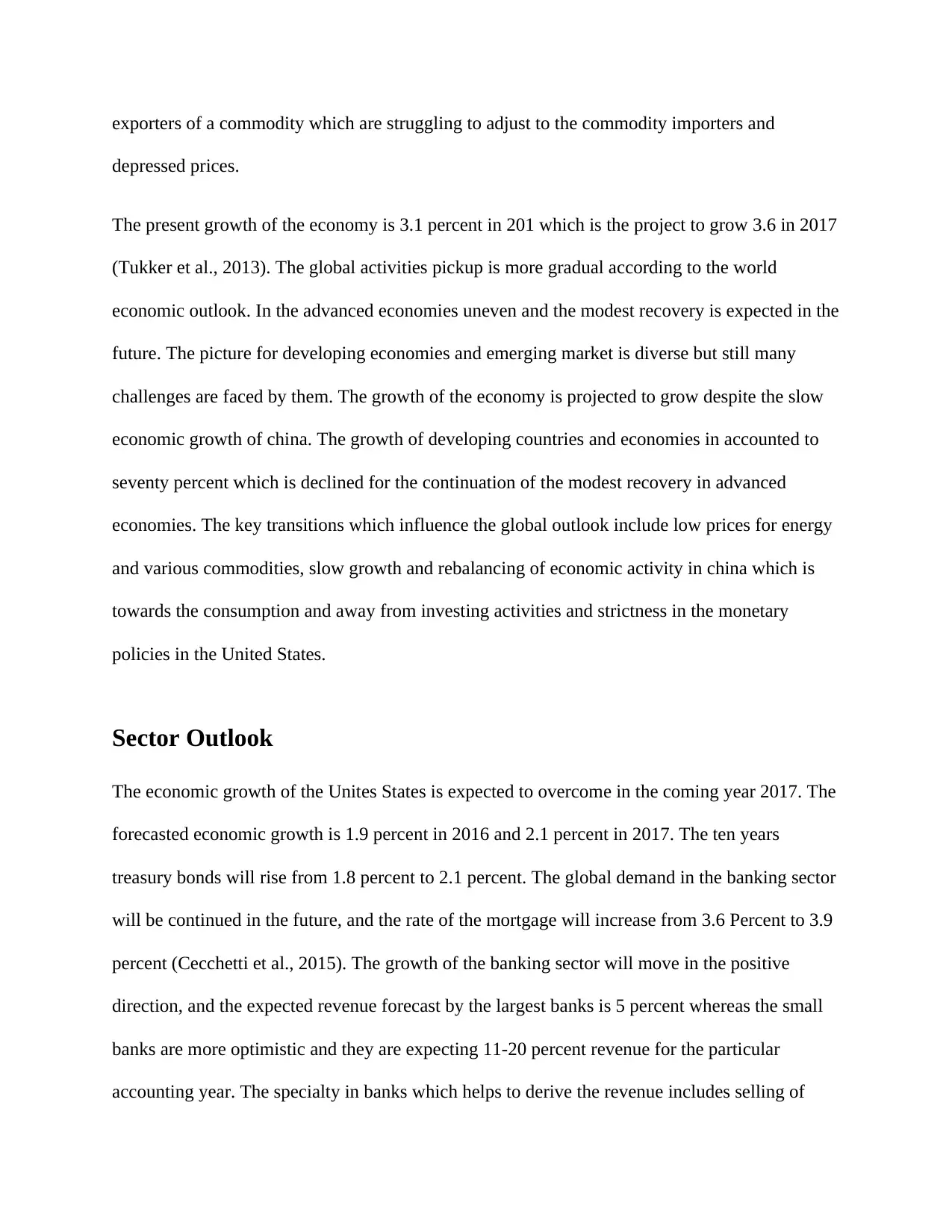
exporters of a commodity which are struggling to adjust to the commodity importers and
depressed prices.
The present growth of the economy is 3.1 percent in 201 which is the project to grow 3.6 in 2017
(Tukker et al., 2013). The global activities pickup is more gradual according to the world
economic outlook. In the advanced economies uneven and the modest recovery is expected in the
future. The picture for developing economies and emerging market is diverse but still many
challenges are faced by them. The growth of the economy is projected to grow despite the slow
economic growth of china. The growth of developing countries and economies in accounted to
seventy percent which is declined for the continuation of the modest recovery in advanced
economies. The key transitions which influence the global outlook include low prices for energy
and various commodities, slow growth and rebalancing of economic activity in china which is
towards the consumption and away from investing activities and strictness in the monetary
policies in the United States.
Sector Outlook
The economic growth of the Unites States is expected to overcome in the coming year 2017. The
forecasted economic growth is 1.9 percent in 2016 and 2.1 percent in 2017. The ten years
treasury bonds will rise from 1.8 percent to 2.1 percent. The global demand in the banking sector
will be continued in the future, and the rate of the mortgage will increase from 3.6 Percent to 3.9
percent (Cecchetti et al., 2015). The growth of the banking sector will move in the positive
direction, and the expected revenue forecast by the largest banks is 5 percent whereas the small
banks are more optimistic and they are expecting 11-20 percent revenue for the particular
accounting year. The specialty in banks which helps to derive the revenue includes selling of
depressed prices.
The present growth of the economy is 3.1 percent in 201 which is the project to grow 3.6 in 2017
(Tukker et al., 2013). The global activities pickup is more gradual according to the world
economic outlook. In the advanced economies uneven and the modest recovery is expected in the
future. The picture for developing economies and emerging market is diverse but still many
challenges are faced by them. The growth of the economy is projected to grow despite the slow
economic growth of china. The growth of developing countries and economies in accounted to
seventy percent which is declined for the continuation of the modest recovery in advanced
economies. The key transitions which influence the global outlook include low prices for energy
and various commodities, slow growth and rebalancing of economic activity in china which is
towards the consumption and away from investing activities and strictness in the monetary
policies in the United States.
Sector Outlook
The economic growth of the Unites States is expected to overcome in the coming year 2017. The
forecasted economic growth is 1.9 percent in 2016 and 2.1 percent in 2017. The ten years
treasury bonds will rise from 1.8 percent to 2.1 percent. The global demand in the banking sector
will be continued in the future, and the rate of the mortgage will increase from 3.6 Percent to 3.9
percent (Cecchetti et al., 2015). The growth of the banking sector will move in the positive
direction, and the expected revenue forecast by the largest banks is 5 percent whereas the small
banks are more optimistic and they are expecting 11-20 percent revenue for the particular
accounting year. The specialty in banks which helps to derive the revenue includes selling of
Paraphrase This Document
Need a fresh take? Get an instant paraphrase of this document with our AI Paraphraser
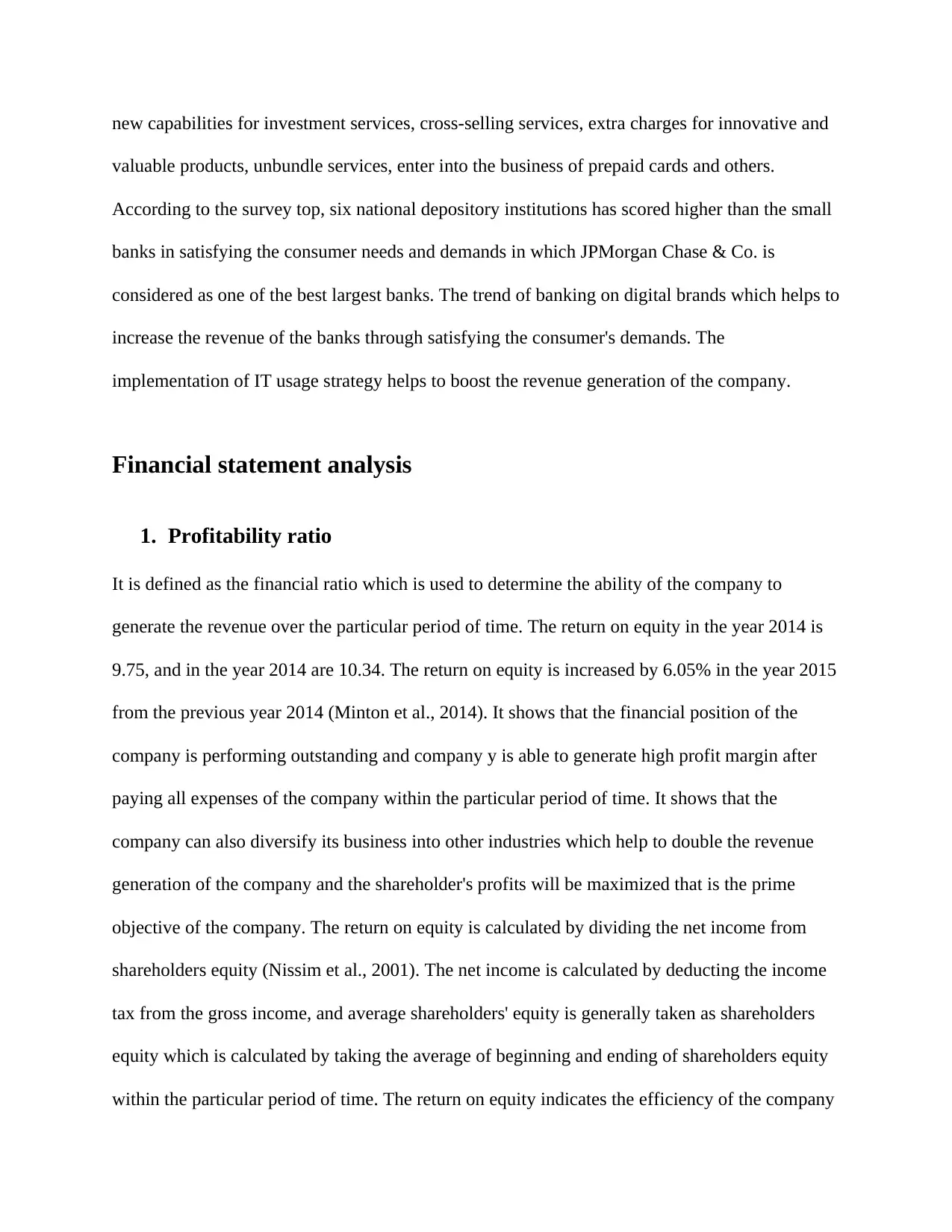
new capabilities for investment services, cross-selling services, extra charges for innovative and
valuable products, unbundle services, enter into the business of prepaid cards and others.
According to the survey top, six national depository institutions has scored higher than the small
banks in satisfying the consumer needs and demands in which JPMorgan Chase & Co. is
considered as one of the best largest banks. The trend of banking on digital brands which helps to
increase the revenue of the banks through satisfying the consumer's demands. The
implementation of IT usage strategy helps to boost the revenue generation of the company.
Financial statement analysis
1. Profitability ratio
It is defined as the financial ratio which is used to determine the ability of the company to
generate the revenue over the particular period of time. The return on equity in the year 2014 is
9.75, and in the year 2014 are 10.34. The return on equity is increased by 6.05% in the year 2015
from the previous year 2014 (Minton et al., 2014). It shows that the financial position of the
company is performing outstanding and company y is able to generate high profit margin after
paying all expenses of the company within the particular period of time. It shows that the
company can also diversify its business into other industries which help to double the revenue
generation of the company and the shareholder's profits will be maximized that is the prime
objective of the company. The return on equity is calculated by dividing the net income from
shareholders equity (Nissim et al., 2001). The net income is calculated by deducting the income
tax from the gross income, and average shareholders' equity is generally taken as shareholders
equity which is calculated by taking the average of beginning and ending of shareholders equity
within the particular period of time. The return on equity indicates the efficiency of the company
valuable products, unbundle services, enter into the business of prepaid cards and others.
According to the survey top, six national depository institutions has scored higher than the small
banks in satisfying the consumer needs and demands in which JPMorgan Chase & Co. is
considered as one of the best largest banks. The trend of banking on digital brands which helps to
increase the revenue of the banks through satisfying the consumer's demands. The
implementation of IT usage strategy helps to boost the revenue generation of the company.
Financial statement analysis
1. Profitability ratio
It is defined as the financial ratio which is used to determine the ability of the company to
generate the revenue over the particular period of time. The return on equity in the year 2014 is
9.75, and in the year 2014 are 10.34. The return on equity is increased by 6.05% in the year 2015
from the previous year 2014 (Minton et al., 2014). It shows that the financial position of the
company is performing outstanding and company y is able to generate high profit margin after
paying all expenses of the company within the particular period of time. It shows that the
company can also diversify its business into other industries which help to double the revenue
generation of the company and the shareholder's profits will be maximized that is the prime
objective of the company. The return on equity is calculated by dividing the net income from
shareholders equity (Nissim et al., 2001). The net income is calculated by deducting the income
tax from the gross income, and average shareholders' equity is generally taken as shareholders
equity which is calculated by taking the average of beginning and ending of shareholders equity
within the particular period of time. The return on equity indicates the efficiency of the company
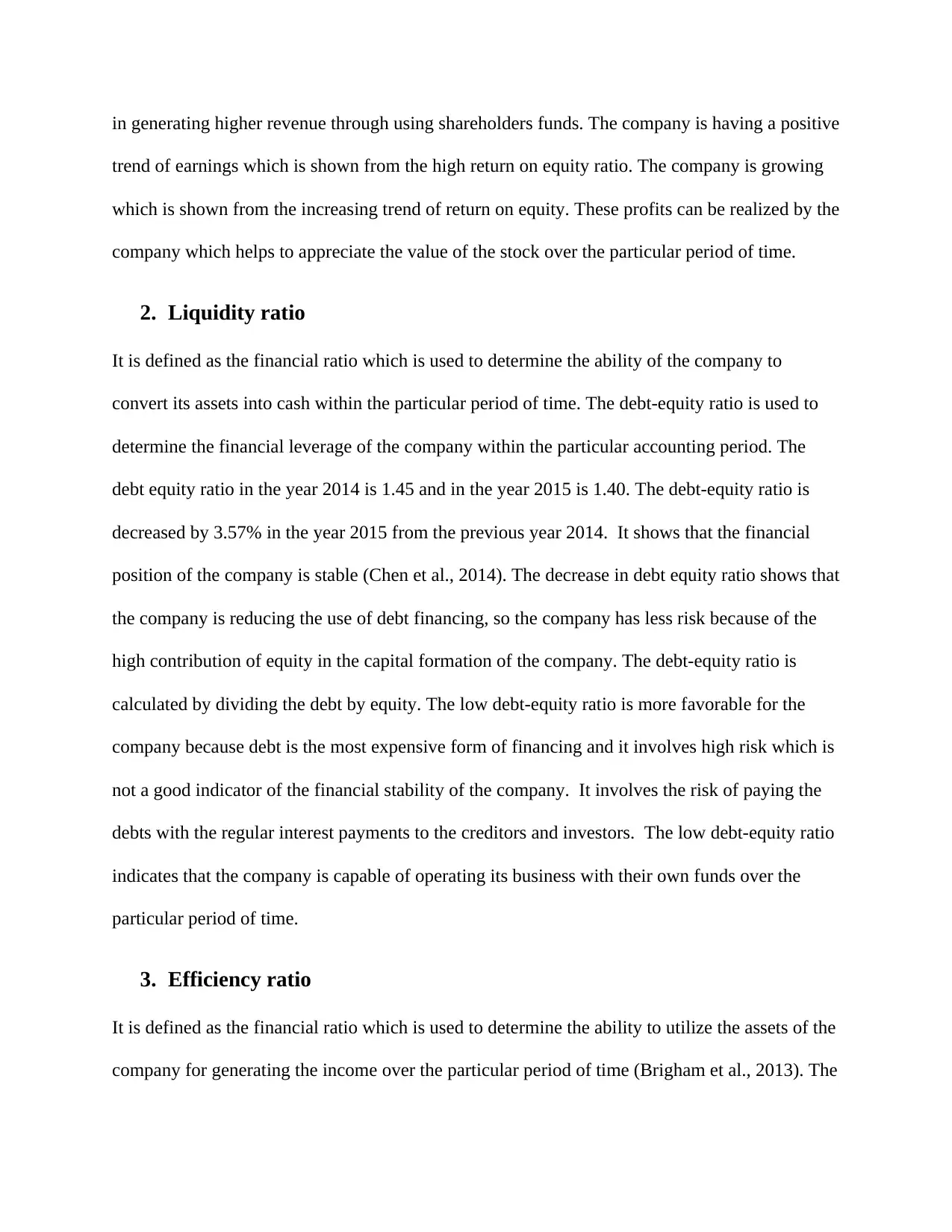
in generating higher revenue through using shareholders funds. The company is having a positive
trend of earnings which is shown from the high return on equity ratio. The company is growing
which is shown from the increasing trend of return on equity. These profits can be realized by the
company which helps to appreciate the value of the stock over the particular period of time.
2. Liquidity ratio
It is defined as the financial ratio which is used to determine the ability of the company to
convert its assets into cash within the particular period of time. The debt-equity ratio is used to
determine the financial leverage of the company within the particular accounting period. The
debt equity ratio in the year 2014 is 1.45 and in the year 2015 is 1.40. The debt-equity ratio is
decreased by 3.57% in the year 2015 from the previous year 2014. It shows that the financial
position of the company is stable (Chen et al., 2014). The decrease in debt equity ratio shows that
the company is reducing the use of debt financing, so the company has less risk because of the
high contribution of equity in the capital formation of the company. The debt-equity ratio is
calculated by dividing the debt by equity. The low debt-equity ratio is more favorable for the
company because debt is the most expensive form of financing and it involves high risk which is
not a good indicator of the financial stability of the company. It involves the risk of paying the
debts with the regular interest payments to the creditors and investors. The low debt-equity ratio
indicates that the company is capable of operating its business with their own funds over the
particular period of time.
3. Efficiency ratio
It is defined as the financial ratio which is used to determine the ability to utilize the assets of the
company for generating the income over the particular period of time (Brigham et al., 2013). The
trend of earnings which is shown from the high return on equity ratio. The company is growing
which is shown from the increasing trend of return on equity. These profits can be realized by the
company which helps to appreciate the value of the stock over the particular period of time.
2. Liquidity ratio
It is defined as the financial ratio which is used to determine the ability of the company to
convert its assets into cash within the particular period of time. The debt-equity ratio is used to
determine the financial leverage of the company within the particular accounting period. The
debt equity ratio in the year 2014 is 1.45 and in the year 2015 is 1.40. The debt-equity ratio is
decreased by 3.57% in the year 2015 from the previous year 2014. It shows that the financial
position of the company is stable (Chen et al., 2014). The decrease in debt equity ratio shows that
the company is reducing the use of debt financing, so the company has less risk because of the
high contribution of equity in the capital formation of the company. The debt-equity ratio is
calculated by dividing the debt by equity. The low debt-equity ratio is more favorable for the
company because debt is the most expensive form of financing and it involves high risk which is
not a good indicator of the financial stability of the company. It involves the risk of paying the
debts with the regular interest payments to the creditors and investors. The low debt-equity ratio
indicates that the company is capable of operating its business with their own funds over the
particular period of time.
3. Efficiency ratio
It is defined as the financial ratio which is used to determine the ability to utilize the assets of the
company for generating the income over the particular period of time (Brigham et al., 2013). The
⊘ This is a preview!⊘
Do you want full access?
Subscribe today to unlock all pages.

Trusted by 1+ million students worldwide
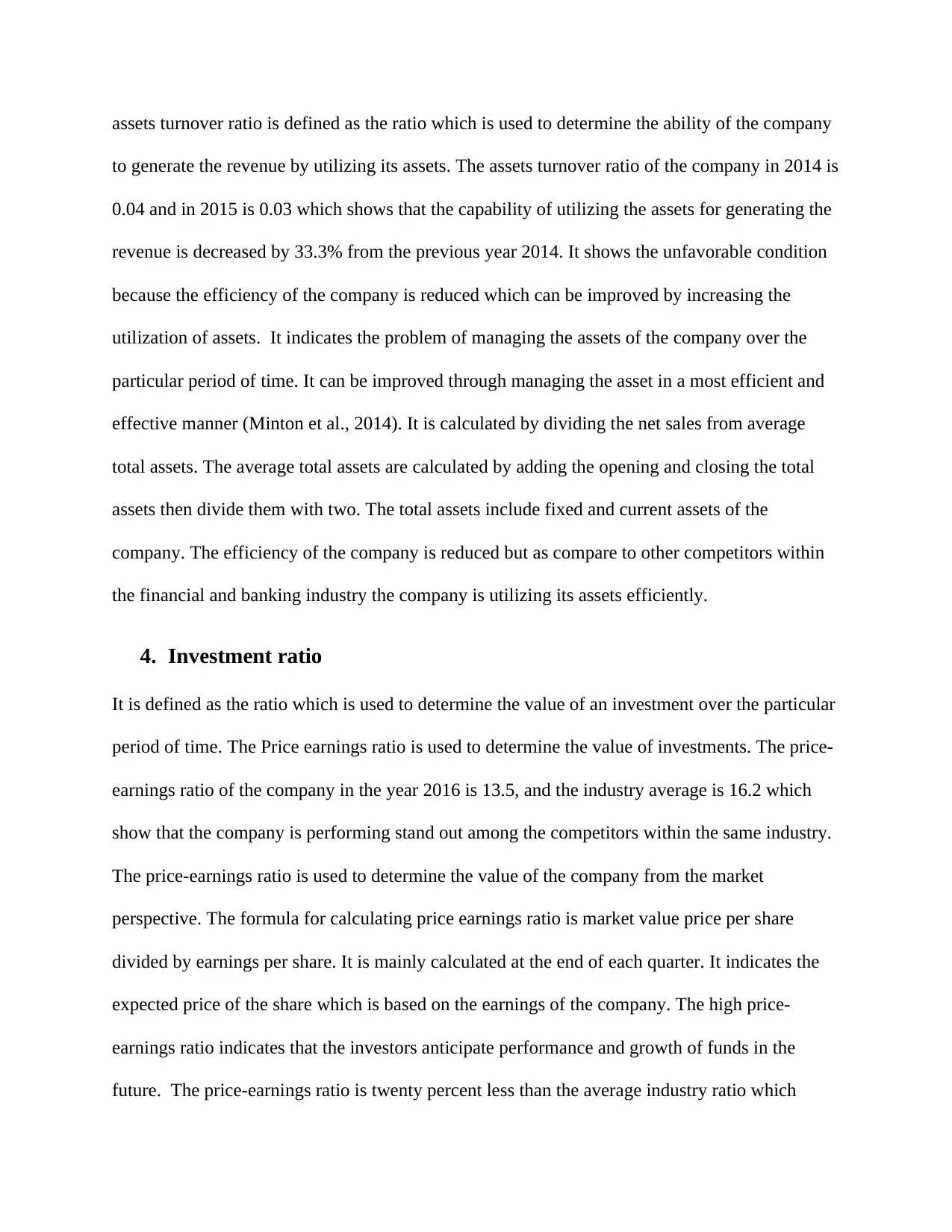
assets turnover ratio is defined as the ratio which is used to determine the ability of the company
to generate the revenue by utilizing its assets. The assets turnover ratio of the company in 2014 is
0.04 and in 2015 is 0.03 which shows that the capability of utilizing the assets for generating the
revenue is decreased by 33.3% from the previous year 2014. It shows the unfavorable condition
because the efficiency of the company is reduced which can be improved by increasing the
utilization of assets. It indicates the problem of managing the assets of the company over the
particular period of time. It can be improved through managing the asset in a most efficient and
effective manner (Minton et al., 2014). It is calculated by dividing the net sales from average
total assets. The average total assets are calculated by adding the opening and closing the total
assets then divide them with two. The total assets include fixed and current assets of the
company. The efficiency of the company is reduced but as compare to other competitors within
the financial and banking industry the company is utilizing its assets efficiently.
4. Investment ratio
It is defined as the ratio which is used to determine the value of an investment over the particular
period of time. The Price earnings ratio is used to determine the value of investments. The price-
earnings ratio of the company in the year 2016 is 13.5, and the industry average is 16.2 which
show that the company is performing stand out among the competitors within the same industry.
The price-earnings ratio is used to determine the value of the company from the market
perspective. The formula for calculating price earnings ratio is market value price per share
divided by earnings per share. It is mainly calculated at the end of each quarter. It indicates the
expected price of the share which is based on the earnings of the company. The high price-
earnings ratio indicates that the investors anticipate performance and growth of funds in the
future. The price-earnings ratio is twenty percent less than the average industry ratio which
to generate the revenue by utilizing its assets. The assets turnover ratio of the company in 2014 is
0.04 and in 2015 is 0.03 which shows that the capability of utilizing the assets for generating the
revenue is decreased by 33.3% from the previous year 2014. It shows the unfavorable condition
because the efficiency of the company is reduced which can be improved by increasing the
utilization of assets. It indicates the problem of managing the assets of the company over the
particular period of time. It can be improved through managing the asset in a most efficient and
effective manner (Minton et al., 2014). It is calculated by dividing the net sales from average
total assets. The average total assets are calculated by adding the opening and closing the total
assets then divide them with two. The total assets include fixed and current assets of the
company. The efficiency of the company is reduced but as compare to other competitors within
the financial and banking industry the company is utilizing its assets efficiently.
4. Investment ratio
It is defined as the ratio which is used to determine the value of an investment over the particular
period of time. The Price earnings ratio is used to determine the value of investments. The price-
earnings ratio of the company in the year 2016 is 13.5, and the industry average is 16.2 which
show that the company is performing stand out among the competitors within the same industry.
The price-earnings ratio is used to determine the value of the company from the market
perspective. The formula for calculating price earnings ratio is market value price per share
divided by earnings per share. It is mainly calculated at the end of each quarter. It indicates the
expected price of the share which is based on the earnings of the company. The high price-
earnings ratio indicates that the investors anticipate performance and growth of funds in the
future. The price-earnings ratio is twenty percent less than the average industry ratio which
Paraphrase This Document
Need a fresh take? Get an instant paraphrase of this document with our AI Paraphraser
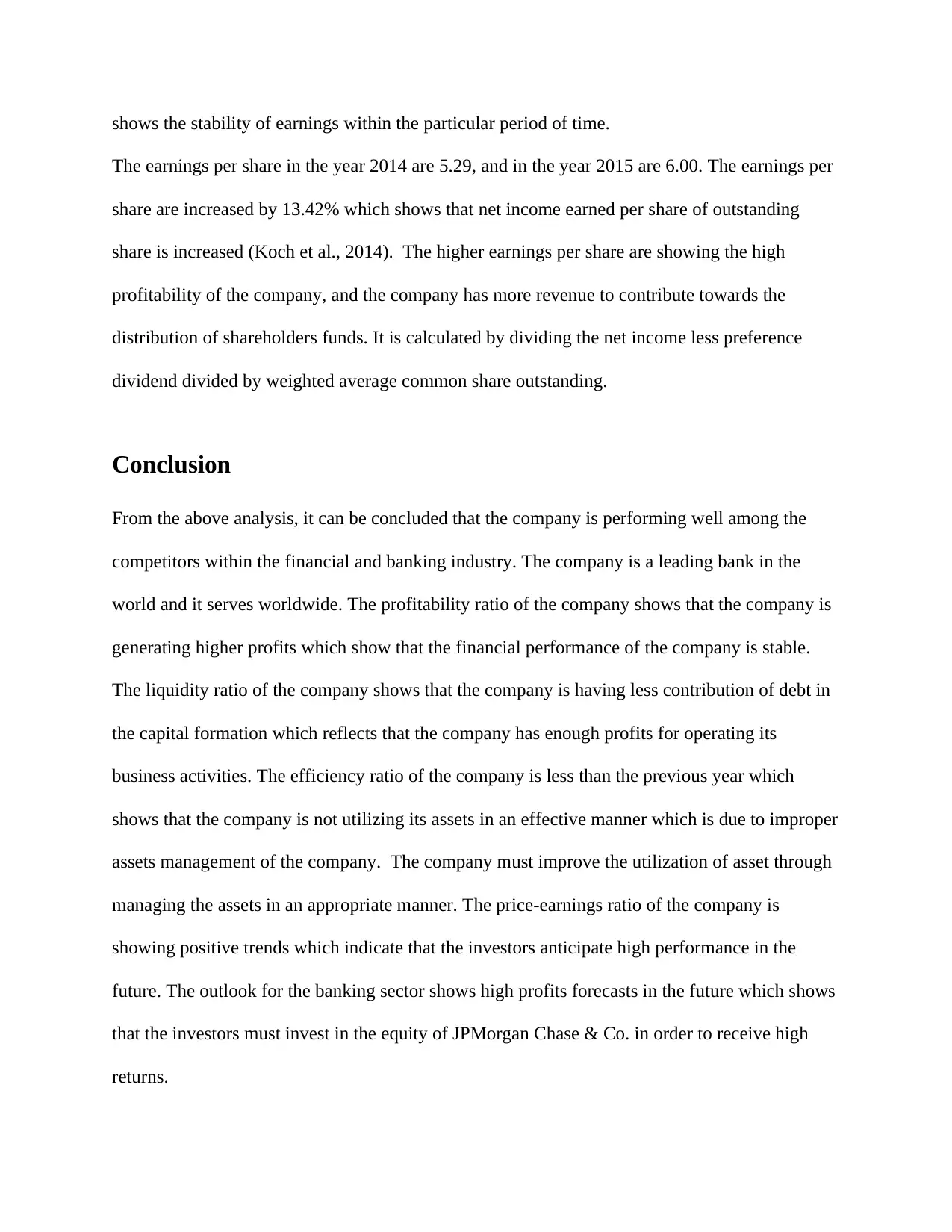
shows the stability of earnings within the particular period of time.
The earnings per share in the year 2014 are 5.29, and in the year 2015 are 6.00. The earnings per
share are increased by 13.42% which shows that net income earned per share of outstanding
share is increased (Koch et al., 2014). The higher earnings per share are showing the high
profitability of the company, and the company has more revenue to contribute towards the
distribution of shareholders funds. It is calculated by dividing the net income less preference
dividend divided by weighted average common share outstanding.
Conclusion
From the above analysis, it can be concluded that the company is performing well among the
competitors within the financial and banking industry. The company is a leading bank in the
world and it serves worldwide. The profitability ratio of the company shows that the company is
generating higher profits which show that the financial performance of the company is stable.
The liquidity ratio of the company shows that the company is having less contribution of debt in
the capital formation which reflects that the company has enough profits for operating its
business activities. The efficiency ratio of the company is less than the previous year which
shows that the company is not utilizing its assets in an effective manner which is due to improper
assets management of the company. The company must improve the utilization of asset through
managing the assets in an appropriate manner. The price-earnings ratio of the company is
showing positive trends which indicate that the investors anticipate high performance in the
future. The outlook for the banking sector shows high profits forecasts in the future which shows
that the investors must invest in the equity of JPMorgan Chase & Co. in order to receive high
returns.
The earnings per share in the year 2014 are 5.29, and in the year 2015 are 6.00. The earnings per
share are increased by 13.42% which shows that net income earned per share of outstanding
share is increased (Koch et al., 2014). The higher earnings per share are showing the high
profitability of the company, and the company has more revenue to contribute towards the
distribution of shareholders funds. It is calculated by dividing the net income less preference
dividend divided by weighted average common share outstanding.
Conclusion
From the above analysis, it can be concluded that the company is performing well among the
competitors within the financial and banking industry. The company is a leading bank in the
world and it serves worldwide. The profitability ratio of the company shows that the company is
generating higher profits which show that the financial performance of the company is stable.
The liquidity ratio of the company shows that the company is having less contribution of debt in
the capital formation which reflects that the company has enough profits for operating its
business activities. The efficiency ratio of the company is less than the previous year which
shows that the company is not utilizing its assets in an effective manner which is due to improper
assets management of the company. The company must improve the utilization of asset through
managing the assets in an appropriate manner. The price-earnings ratio of the company is
showing positive trends which indicate that the investors anticipate high performance in the
future. The outlook for the banking sector shows high profits forecasts in the future which shows
that the investors must invest in the equity of JPMorgan Chase & Co. in order to receive high
returns.

⊘ This is a preview!⊘
Do you want full access?
Subscribe today to unlock all pages.

Trusted by 1+ million students worldwide
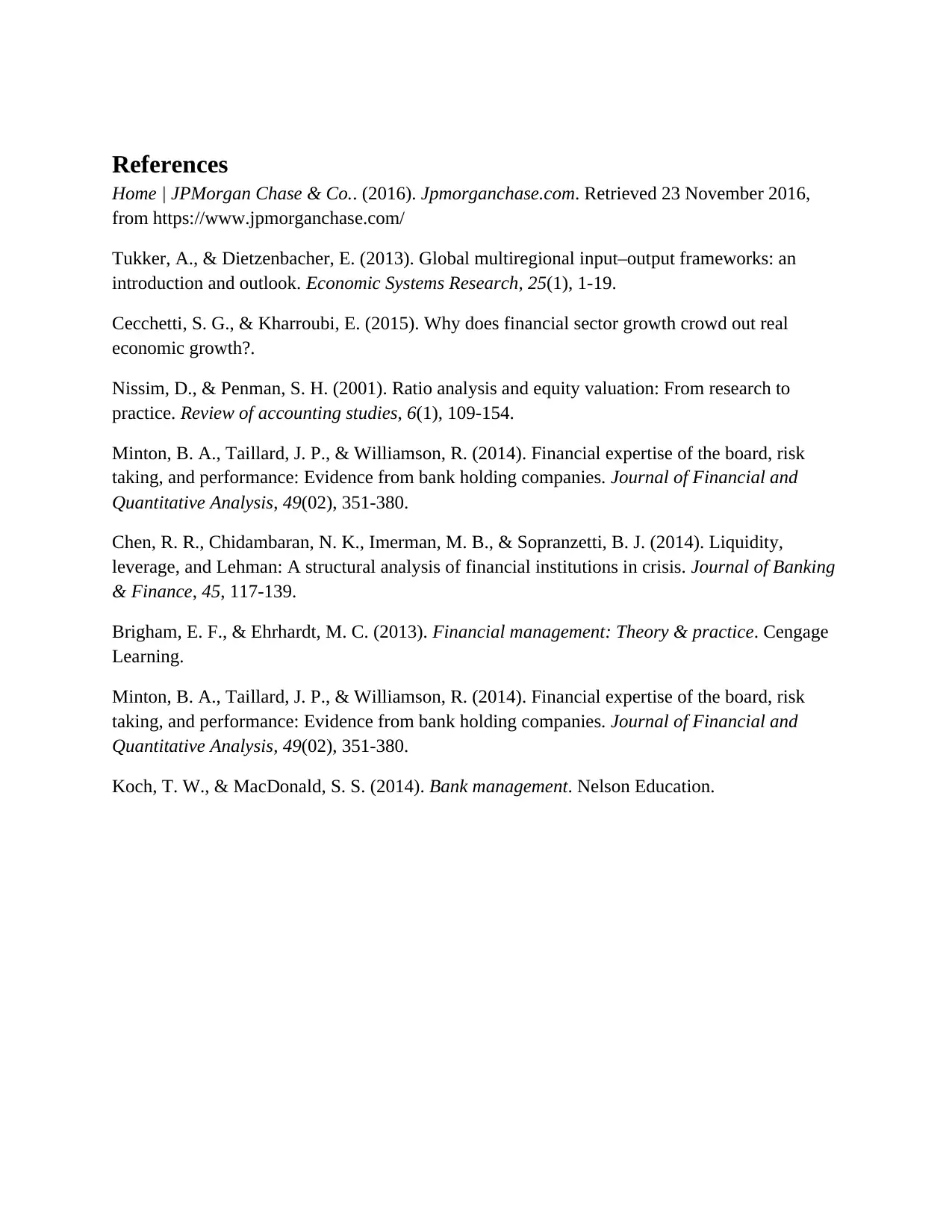
References
Home | JPMorgan Chase & Co.. (2016). Jpmorganchase.com. Retrieved 23 November 2016,
from https://www.jpmorganchase.com/
Tukker, A., & Dietzenbacher, E. (2013). Global multiregional input–output frameworks: an
introduction and outlook. Economic Systems Research, 25(1), 1-19.
Cecchetti, S. G., & Kharroubi, E. (2015). Why does financial sector growth crowd out real
economic growth?.
Nissim, D., & Penman, S. H. (2001). Ratio analysis and equity valuation: From research to
practice. Review of accounting studies, 6(1), 109-154.
Minton, B. A., Taillard, J. P., & Williamson, R. (2014). Financial expertise of the board, risk
taking, and performance: Evidence from bank holding companies. Journal of Financial and
Quantitative Analysis, 49(02), 351-380.
Chen, R. R., Chidambaran, N. K., Imerman, M. B., & Sopranzetti, B. J. (2014). Liquidity,
leverage, and Lehman: A structural analysis of financial institutions in crisis. Journal of Banking
& Finance, 45, 117-139.
Brigham, E. F., & Ehrhardt, M. C. (2013). Financial management: Theory & practice. Cengage
Learning.
Minton, B. A., Taillard, J. P., & Williamson, R. (2014). Financial expertise of the board, risk
taking, and performance: Evidence from bank holding companies. Journal of Financial and
Quantitative Analysis, 49(02), 351-380.
Koch, T. W., & MacDonald, S. S. (2014). Bank management. Nelson Education.
Home | JPMorgan Chase & Co.. (2016). Jpmorganchase.com. Retrieved 23 November 2016,
from https://www.jpmorganchase.com/
Tukker, A., & Dietzenbacher, E. (2013). Global multiregional input–output frameworks: an
introduction and outlook. Economic Systems Research, 25(1), 1-19.
Cecchetti, S. G., & Kharroubi, E. (2015). Why does financial sector growth crowd out real
economic growth?.
Nissim, D., & Penman, S. H. (2001). Ratio analysis and equity valuation: From research to
practice. Review of accounting studies, 6(1), 109-154.
Minton, B. A., Taillard, J. P., & Williamson, R. (2014). Financial expertise of the board, risk
taking, and performance: Evidence from bank holding companies. Journal of Financial and
Quantitative Analysis, 49(02), 351-380.
Chen, R. R., Chidambaran, N. K., Imerman, M. B., & Sopranzetti, B. J. (2014). Liquidity,
leverage, and Lehman: A structural analysis of financial institutions in crisis. Journal of Banking
& Finance, 45, 117-139.
Brigham, E. F., & Ehrhardt, M. C. (2013). Financial management: Theory & practice. Cengage
Learning.
Minton, B. A., Taillard, J. P., & Williamson, R. (2014). Financial expertise of the board, risk
taking, and performance: Evidence from bank holding companies. Journal of Financial and
Quantitative Analysis, 49(02), 351-380.
Koch, T. W., & MacDonald, S. S. (2014). Bank management. Nelson Education.
1 out of 10
Related Documents
Your All-in-One AI-Powered Toolkit for Academic Success.
+13062052269
info@desklib.com
Available 24*7 on WhatsApp / Email
![[object Object]](/_next/static/media/star-bottom.7253800d.svg)
Unlock your academic potential
Copyright © 2020–2025 A2Z Services. All Rights Reserved. Developed and managed by ZUCOL.





